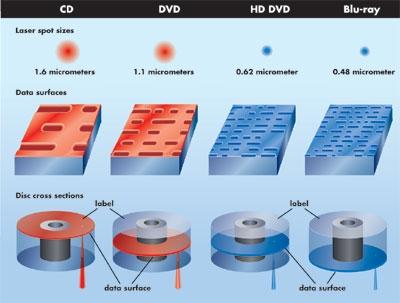Inside Tech: Blu-ray & HD DVD

Likewise, Blu-ray Discs (BDs) and HD DVDs have the potential to provide the highest resolution that the current high-def video standard allows. They could even provide unprecedented audio performance by using various advanced capabilities, but these still weren't finalized as of this writing (height channels, anyone?). Both systems also promise seamless integration with the Internet and extensive new capabilities for videogame producers.
All these new powers stem from two breakthroughs. First is an increase in the maximum data rate for streaming information off the discs - 36 megabits per second (Mbps) for both BD and HD DVD compared with 11 Mbps for standard DVD - which allows these discs to provide even better picture quality than current high-definition TV broadcasts. They'll also be able to handle several applications simultaneously, letting you do things like call up background audio and video commentaries without interrupting the movie or choose from multiple camera angles on the fly for the scene you're watching.
The second breakthrough is far greater storage capacity than DVD. While a single-sided, single-layer DVD can hold 4.7 gigabytes (GB), a single-sided, single-layer HD DVD can hold 15 GB, and a comparable Blu-ray Disc can hold 25 GB (see the table on page 81 for detailed technical comparisons between the four formats). While each high-def format starts with a new blue laser to achieve these breakthroughs, they follow radically different paths from there.
Honey, I Shrunk the Pits The key technology behind both HD DVD and Blu-ray is the blue laser, an evolutionary development of the infrared and red lasers used in CD and DVD players. The wavelength of the light coming from the blue lasers in both high-def disc formats is 405 nanometers (billionths of a meter), which is shorter than the DVD wavelength of 650 nanometers (a pure red) and nearly half the CD wavelength of 780 nanometers (in the near-visible infrared). Using a shorter laser wavelength allows a much smaller spot to be focused onto the reflective data layer (see "Laser spot sizes" in the diagram below). Top, the red and blue laser spots used to read the four optical-disc formats are shown to scale, though greatly enlarged. Middle, the data surfaces are shown to scale in simulations of atomic-force-microscope scans of the pit layers. Bottom, vertically to-scale renditions of the disc layers used by the four formats.
Using a smaller spot lets you shrink everything on the disc pro- portionally to increase the amount of data you can pack in. This happened once before with the move from the CD's infrared laser to DVD's shorter-wavelength red laser. The data-carrying pits and the spacing between revolutions of the pit trail (the "track pitch") are both substantially smaller with Blu-ray and HD DVD than they were with DVD. (Click to see the format specifications PDF and the 'Data surfaces' in the diagram above. It's a delicious historical irony that some of the atomic-force microscope photos on which the diagrams are based were made by dragging a microscopic stylus over the disc - shades of the phonograph!)
Optically, the HD DVD system was arrived at by taking a standard DVD and shrinking the dimensions of the data layer as much as the new laser wavelength allows. DVDs and HD DVDs have the same diameter, and both use the same sandwich construction made up of two 0.6-mm substrates, only one of which usually carries data, bonded with an adhesive to create a disc 1.2-mm thick (same as a CD). DVDs and HD DVDs have the same thickness as CDs to retain compatibility with current disc-loading mechanisms. Otherwise, DVDs and HD DVDs could be half as thick.



























































